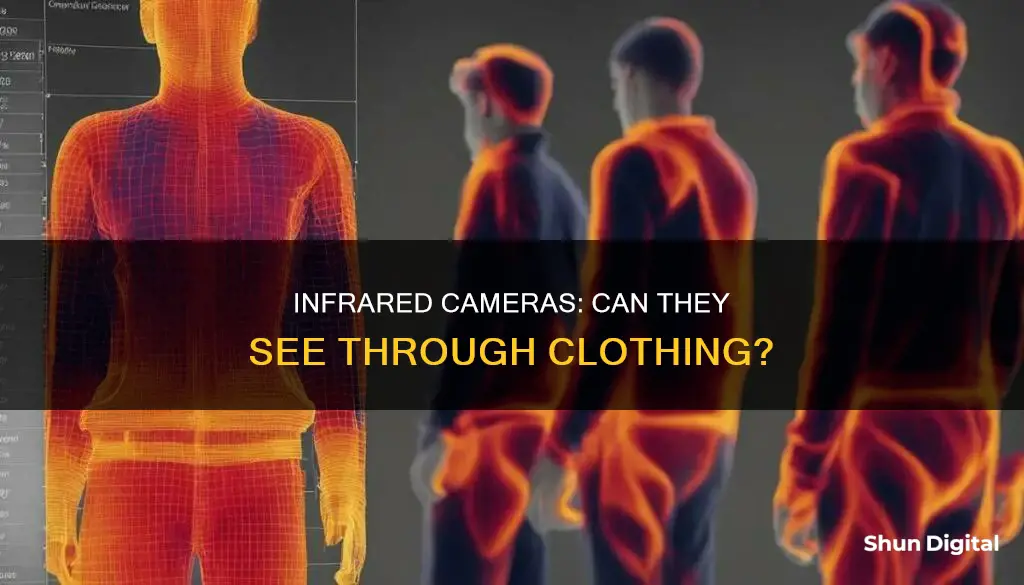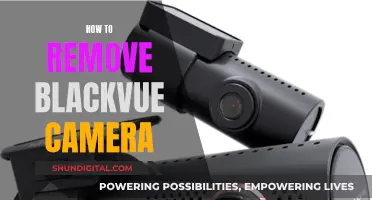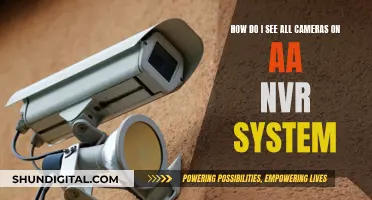
Infrared cameras can see through some clothing, but not in the way that many people expect. While infrared cameras cannot provide an exact depiction of the anatomy, they can detect the temperature of the body underneath the clothing. Certain parts of the body are closer to the clothing and therefore appear warmer, or are actually warmer. In addition, if a person is carrying something that is heating or cooling the cloth that covers it, the thermal camera will show the heat signature on the cloth.
The ability of infrared cameras to see through clothing also depends on the type of fabric and its weave. Some synthetic fibres, particularly when wet, are more likely to allow certain wavelengths to pass through.
The OnePlus 8 Pro smartphone, for example, can see through some plastics and dark clothing using infrared light.
| Characteristics | Values |
|---|---|
| Can infrared cameras see through clothes? | No, but they can detect the temperature of the cloth. |
| Can infrared cameras see through thin clothes? | Yes, but only under certain conditions. |
| Can infrared cameras see through thick clothes? | No. |
| Can infrared cameras see through wet clothes? | Yes, under certain conditions. |
| Can infrared cameras see through synthetic fibres? | Yes, under certain conditions. |
What You'll Learn
- IR can see through some clothes, depending on the fabric and its weave
- IR cameras can see through thin black plastic
- IR cameras can see through some clothing when a strong backlight is present
- Thermal imaging cameras can't see through walls but can detect surface temperatures
- Thermal imaging cameras can't see through metal but can detect the surface temperature of the object

IR can see through some clothes, depending on the fabric and its weave
Infrared (IR) cameras can see through some clothes, depending on the fabric and its weave. IR cameras can see through certain types of clothing, particularly synthetic fibres, and especially when wet.
The OnePlus 8 Pro smartphone, for example, can see through some plastics and dark clothing using infrared light. The Photochrome filter on the camera app uses infrared light, which can see through certain plastics and fabrics. In a demonstration, the camera was able to see through a black t-shirt to reveal an iPhone box held underneath.
Infrared light passes through certain materials in a way that visible light does not, so these materials appear transparent when viewed through an infrared camera. However, it is important to note that the images produced by the filter are of low resolution, and it is generally difficult to see any detail through plastic and fabric.
Additionally, the type of infrared camera also matters. "Ordinary infrared cameras" can only image near-infrared, specifically waves up to 1100 nm. On the other hand, thermal imaging cameras capture much longer infrared waves, often waves that are no longer infrared. While thermal imaging cameras can see underneath clothing, they cannot provide an exact depiction of the anatomy.
In conclusion, while it is possible for IR cameras to see through some types of clothing, it is not a common occurrence and depends on the fabric type, weave, and moisture level.
Menards' Employee Surveillance: Cameras Watching Every Move
You may want to see also

IR cameras can see through thin black plastic
The reason IR cameras can see through thin black plastic is that infrared light can pass through some materials that regular light cannot. The infrared sensors on the OnePlus 8 Pro can see through very thin black plastic, such as the casing on an Apple TV, or on objects that already use semi-transparent black plastic, such as the Nintendo Switch Pro Controller.
The ability of IR cameras to see through thin black plastic is not limited to smartphones. Some laptops with infrared cameras can also see through thin black plastic and clothing. Additionally, high-power IR cameras used for surveillance have been reported to see through certain types of clothing, usually red in colour.
It is important to note that while IR cameras can see through thin black plastic, they cannot see through all plastics. Some plastics, such as Polyethylene, are transparent to infrared radiation while being opaque to visible light. This property of Polyethylene is why it is often used for the windows of IR cameras.
CVS Camera Surveillance: What You Need to Know
You may want to see also

IR cameras can see through some clothing when a strong backlight is present
The ability of the phone to see through materials was discovered by numerous 8 Pro owners and reviewers. The images produced by the filter are of low resolution, and it is quite difficult to see any detail through plastic and fabric. However, given the phone can see through some clothing, there are obvious privacy issues to be addressed.
The Sony Nightshot, a camera with an IR lamp and a "night mode" for filming in darkness, is another example of a device that could see through certain types of clothing such as cotton when tricked into "night mode" in daylight.
The ability of IR cameras to see through clothing depends on the fabric type, weave, and whether the clothing is wet. Synthetic fibres, particularly when wet, are more likely to be seen through by IR cameras.
It is important to note that IR cameras do not provide an exact depiction of the anatomy, and only detect surface temperatures.
Apple Watch Series 5: Camera Expectations Explained
You may want to see also

Thermal imaging cameras can't see through walls but can detect surface temperatures
Thermal imaging cameras have a wide range of applications, from military operations to firefighting and home inspections. But can they see through walls?
The short answer is no, thermal imaging cameras cannot see through walls. However, they can detect surface temperatures and heat patterns on the wall's surface. This is because walls are generally thick and insulated enough to block infrared radiation from passing through. So, when you point a thermal camera at a wall, it will only detect the heat coming from the wall itself and not what's behind it.
However, if there is something inside the wall that causes a significant temperature difference, a thermal imaging camera may be able to detect it. For example, if there is a water leak or missing insulation, the affected area of the wall may be cooler or warmer than the surrounding areas, and this temperature difference will be visible on the thermal image. Similarly, if there are pipes, wires, or ducts inside the wall that are hotter or colder than the surrounding structure, the thermal camera will be able to detect these heat patterns.
Skilled thermographers can interpret these thermal images to identify issues such as leaks, blockages, or breaks in insulation. By using building plans that indicate the locations of internal elements, inspection teams can maximise the accuracy of their diagnostics.
While thermal imaging cameras cannot see through walls, they are still incredibly useful in various industries. For example, in building diagnostics, inspectors can use thermal cameras to identify missing insulation, air leaks, and moisture damage by visualising heat loss and energy waste. Additionally, in preventative maintenance, thermal cameras can scan mechanical parts, pipes, and tanks for temperature changes that could indicate wear, blockages, or leaks.
In summary, while thermal imaging cameras cannot see through walls, they are highly effective at detecting surface temperatures and visualising heat patterns, making them invaluable tools for a wide range of applications.
Smart TV Cameras: Where Are They?
You may want to see also

Thermal imaging cameras can't see through metal but can detect the surface temperature of the object
Thermal imaging cameras work by capturing the infrared light emitted by objects, which is then used to create an image based on the temperature of the objects. This means that thermal imaging cameras are unaffected by visible light and can be used in the daytime or at night.
Thermal imaging cameras cannot see through metal objects. However, they can detect the surface temperature of the metal object. If an object on the other side of the metal heats it up, causing a change in the surface temperature, the camera will be able to pick up the temperature variation.
Thermal imaging cameras also cannot see through walls, concrete, or glass. These materials are too thick and have enough insulation to block infrared radiation. However, if something inside the wall, concrete, or glass causes a notable change in temperature, a thermal imaging camera will be able to detect it. For example, if there is a water leak or missing insulation inside a wall, a thermal imaging camera will be able to detect the temperature difference on the surface of the wall.
Thermal imaging cameras can see through thin, opaque plastic. Infrared radiation will pass through thin plastic, allowing the thermal camera to detect objects behind it, while visible light will be blocked. However, thicker plastics will block infrared radiation.
Thermal imaging cameras can also see through dust, smoke, fog, blowing sand, rain, and snow. Soot particles in smoke block visible light but allow infrared radiation to pass through. Similarly, dust, fog, blowing sand, rain, and snow allow infrared radiation to pass through, although the visibility of the thermal image depends on the density and temperature of these substances.
Regarding clothing, it is a myth that thermal imaging cameras can see through thin fabrics. However, if a person is carrying something that is heating or cooling the cloth, the thermal camera will show the heat signature on the cloth.
Pairing TV and Camera in GMod: The Ultimate Guide
You may want to see also
Frequently asked questions
No, infrared cameras can detect the temperature of the cloth but will not see through it. However, if a person is carrying something that is heating or cooling the cloth, the thermal camera will show the heat signature on the cloth.
Thermal imaging cameras image much longer infrared waves, often waves that are no longer infrared at all. The sensor must consist of a semiconductor that responds to these wavelengths, for example, vanadium oxide or amorphous silicon.
No, thermal imaging cameras do not see through surfaces but detect surface temperatures. If a wall is thick enough to trap the heat on one side without leaking it to the other side, then thermal imaging will not detect it.
No, the thermal imaging camera can only pick up the surface temperature of the object. If any object on the other side of the metal heats it up so that the surface temperature changes, the camera will be able to pick up the temperature variation, but will not provide a see-through experience.
No, thermal imagers cannot pick up visible light. Therefore, glass is not seen as transparent when viewed through a thermal imaging camera.







